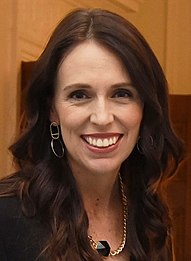2017 New Zealand general election
The 2017 New Zealand general election took place on Saturday 23 September 2017 to elect the membership of the 52nd New Zealand Parliament along with the Prime Minister of New Zealand. The last parliament was elected on 20 September 2014 and officially ended on 22 August 2017.[1]
| |||||||||||||||||||||||||||||||||||||||||||||||||||||||||||||||||||||||||||||||||||||
All 120 seats in the House of Representatives 61 seats needed for a majority | |||||||||||||||||||||||||||||||||||||||||||||||||||||||||||||||||||||||||||||||||||||
|---|---|---|---|---|---|---|---|---|---|---|---|---|---|---|---|---|---|---|---|---|---|---|---|---|---|---|---|---|---|---|---|---|---|---|---|---|---|---|---|---|---|---|---|---|---|---|---|---|---|---|---|---|---|---|---|---|---|---|---|---|---|---|---|---|---|---|---|---|---|---|---|---|---|---|---|---|---|---|---|---|---|---|---|---|---|
| Opinion polls | |||||||||||||||||||||||||||||||||||||||||||||||||||||||||||||||||||||||||||||||||||||
| Turnout | 2,630,173 (79.8%) | ||||||||||||||||||||||||||||||||||||||||||||||||||||||||||||||||||||||||||||||||||||
| |||||||||||||||||||||||||||||||||||||||||||||||||||||||||||||||||||||||||||||||||||||
 Map of the general election. Electorate results are shown on the left, Maori electorate results in the centre, and the list members on the right. | |||||||||||||||||||||||||||||||||||||||||||||||||||||||||||||||||||||||||||||||||||||
| |||||||||||||||||||||||||||||||||||||||||||||||||||||||||||||||||||||||||||||||||||||
Jacinda Ardern became New Zealand's third female Prime Minister, and Winston Peters again became Deputy Prime Minister, a role he had first held in 1996–98.[2] This ended nine years under the National Party Government. Ardern became Prime Minister after the Labour Party agreed to create a coalition with Peters's New Zealand First party, thus making him Deputy Prime Minister. Their shared votes were larger than that of English, thus defeating him.[2]
About
Voters elected 120 members to the House of Representatives under New Zealand's mixed-member proportional (MMP) voting system, a system in which 71 members were elected from single-member electorates and 49 members were elected from closed party lists.
Around 3.57 million people were registered to vote in the election,[3] with 2.63 million (79.8%) turning out. Advance voting proved popular, with 1.24 million votes cast before election day, more than the previous two elections combined.[4]
Candidates
The centre-right National Party, led by Prime Minister Bill English, had governed since 2008 in a minority government. It was the first election for English as incumbent Prime Minister, having replaced John Key on 12 December 2016 and the first since 1975 where both major parties had leadership changes. The main opposition parties to the National government were Labour (the official opposition), led by Jacinda Ardern, the Green Party, and New Zealand First.
Opinion polling
 |  |
Results

References












